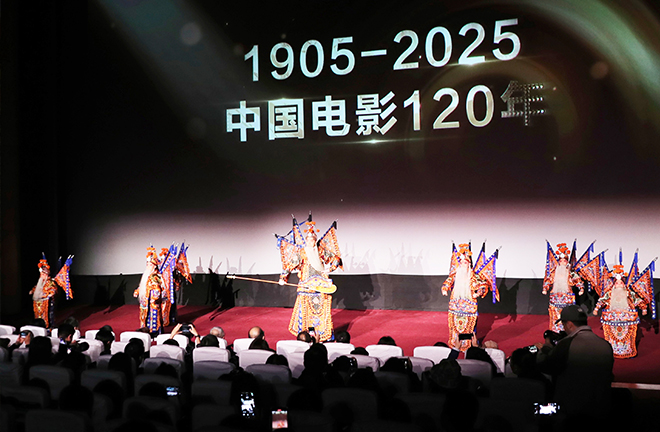Cultural originality as sustained driving force for Chinese cinema

On April 19, a commemorative event marking the 120th anniversary of Chinese cinema was held at Daguanlou Cinema in Beijing. China’s first film, Dingjun Mountain, was adapted from the eponymous Peking Opera. Photo: IC PHOTO
Since the release of Dingjun Mountain—widely regarded as the first Chinese-produced film—in 1905, Chinese cinema has undergone a remarkable journey of change. Over the past 120 years, Chinese film has chronicled social transformations while carrying forward the cultural ethos of each era. Following the reform and opening-up, and especially since the dawn of the new era, Chinese cinema has grown rapidly and gained international prominence. It increasingly serves as an important vehicle for global cultural exchange and the dissemination of Chinese culture, with cultural originality playing a crucial role in this process.
Cultural originality gradually taking shape
Since its inception, Chinese cinema has passed through several defining stages. Faced with the dual challenges of modern state transformation and a national crisis, filmmakers deliberately incorporated elements of traditional Chinese culture—such as opera, martial arts, painting, and classical poetry—using them as artistic means to affirm national consciousness and patriotic sentiment. With the founding of the PRC, film took on new responsibilities in public education and communication, becoming a vital medium for shaping collective identity and contributing to literacy campaigns and science education. Following the reform and opening-up, Chinese cinema began to actively participate in global cultural exchange, experimenting with more diverse characterization, genres, and narrative structures, unleashing powerful cultural originality.
In the 21st century, Chinese cinema has embraced technological innovation while fusing traditional cultural elements with the aesthetic preferences of contemporary audiences, continuously enhancing its cultural originality to strengthen its competitiveness in the process of internationalization. Today, an increasingly rich array of Chinese stories—from ancient civilizations to modern cities, from war epics to science fiction—is reaching global audiences through the silver screen.
Multidimensional development of cultural originality
In the new era, the cultural originality of Chinese cinema manifests across multiple dimensions, marked by the integration of genre innovation, technological breakthroughs, and social responsibility.
In recent years, Chinese science fiction films have gradually matured. Landmark productions such as “The Wandering Earth” have not only achieved major breakthroughs in visual effects, but have also captivated audiences both at home and abroad through intricate narratives and cultural depth. Historical films have likewise made a strong impression, offering visual spectacle while prompting reflection on patriotism, heroism, and national spirit. For example, “The Battle at Lake Changjin” not only portrays the great victory of the Chinese People’s Volunteers and the Chinese people during the War to Resist U.S. Aggression and Aid Korea, but also skillfully weaves together themes of war and human emotion, vividly bringing to life a gallery of historic characters. Technologically, advancements in special effects and digital filmmaking have provided a solid foundation for Chinese cinema to compete internationally and establish a foothold in the global cultural market.
In addition to its entertainment and aesthetic functions, cinema also bears social responsibility. Chinese cinema has long been an important platform for cultural guidance and dissemination. Today, an increasingly conscious sense of social responsibility constitutes a key aspect of its cultural originality. A growing number of works express concern for contemporary realities and the needs of the people. Chinese cinema in the new era has moved beyond one-way messaging or didactic instruction; rather, it seeks to resonate with the audience and inspire reflection on one’s relationship with themselves, with others, with society, and with the nation—ultimately contributing to a shared system of values. Going forward, Chinese cinema must maintain its people-centered orientation.
Cultural originality is not only the driving force behind the robust growth of China’s film industry but also a symbol of national cultural confidence and strength. Released during the 2025 Spring Festival, “Ne Zha 2” not only became the highest-grossing animated film in Chinese cinematic history, but also ranked among the top performers at the global box office, drawing widespread international attention to Chinese animation. This achievement was not merely the commercial success of a single film—it marked the successful reimagining of a traditional Chinese narrative, exemplifying the cultural originality of Chinese cinema in the new era.
Looking ahead, Chinese cinema must continue to cultivate cultural originality, deepen global cultural exchange and integration, and, through continuous innovation, enhance the international influence of Chinese culture while contributing to global cultural development.
Qiu Ping is the associate dean of the School of Innovation and Entrepreneurship at Zhejiang International Studies University. He Dongyu is from the School of Journalism and Communication at Tsinghua University.
Edited by WANG YOURAN

 PRINT
PRINT CLOSE
CLOSE